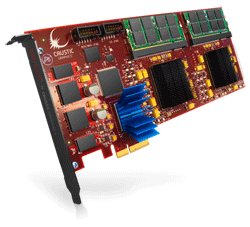
Posted on Tuesday, March 10 2009 @ 18:29 CET by Thomas De Maesschalck
Caustic Graphics, a San Francisco-based startup found by three ex-Apple engineers, officially introduced its raytracing accelerator cards. The CausticOne add-in board card will be launched next month, this accelerator offloads raytracing calculations from your CPU and GPU, and promises 20x faster raytracing graphics than today's fastest graphics cards. And this is just the beginning, Caustic claims its second-generation technology, due early next year, will deliver 200x speed over today's state-of-the-art graphics cards.
Caustic's first-generation technology will deliver an average 20X increase in the speed used to create stunning, realistic 3D imagery for film and video, game development, as well as automotive and consumer product design. The second generation of Caustic's technology, due early next year, is expected to gain an additional order of magnitude in performance, offering 200X speed over today's state-of-the-art graphics products. This massive speed jump is due to Caustic's patent-pending raytracing algorithms implemented in a semiconductor design.
The computational complexity of producing cinema-quality, raytraced 3D images involves large, downstream costs, including slow "black box" design iterations and costly "render farm" server infrastructures. These costs are symptoms of a problem with today's computer designs where CPUs and GPUs are efficient at accelerating the rasterized graphics in video games but woefully inefficient at accelerating cinema-quality raytraced graphics. Caustic's forthcoming standards-based CausticRT™ platform enables highly parallel CPUs and GPUs to massively-accelerate raytracing, putting it on par with rasterization and resulting in cinema-quality 3D delivered interactively on low-cost PCs.
"Real-time raytracing has been the holy grail of computer graphics since 1979 - a dream always on the horizon but never within reach," said Dr. Jon Peddie, of Jon Peddie Research, the computer graphics market research firm in Tiburon, CA. "Demos have been done with 16 or more processors, super computers, and other esoteric devices, but never anything that was within reach of a PC budget. Caustic Graphics has made the breakthrough with a combination of a small hardware accelerator and some very innovative software to be able to deliver real-time, complex, high-resolution raytraced images - this is an amazing accomplishment." The Caustic management team is made up of technical visionaries and graphics experts from Autodesk, Apple, ATI, Intel and NVIDIA. Before starting Caustic, company founders James McCombe, Luke Peterson and Ryan Salsbury worked together at Apple, where McCombe was a lead architect for the company's OpenGL Graphics system and Chief Architect of Apple's rendering algorithms for the iPhone and iPod.
"For years, 3D professionals in multiple industries have labored under the yoke of slow iterations and unwieldy offline render farms," said Caustic Graphics CEO, Ken Daniels. "Caustic puts the power of a render farm, operating at interactive speeds, on every desktop, enabling designers and animators to get from concept to product faster, better and at lower cost." The Caustic product offering will be announced in April 2009.
